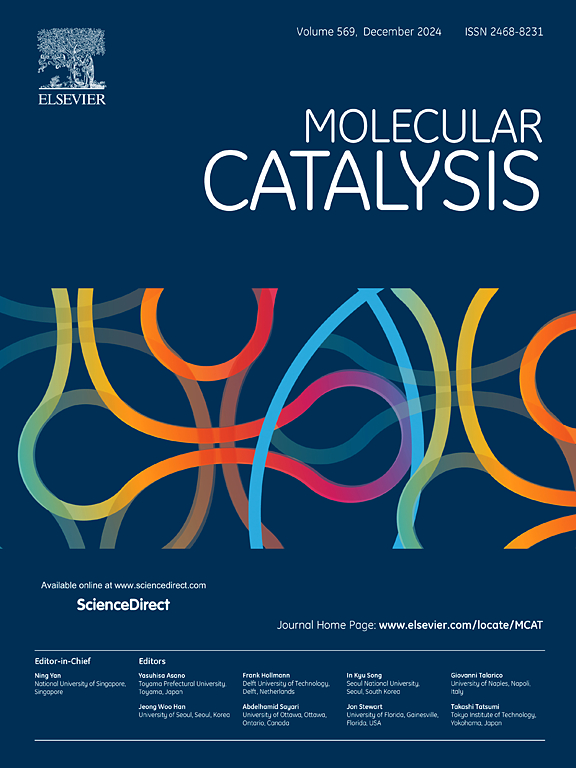Pd/LDH催化剂上CH4和CO2直接偶联乙酸的分步法研究
IF 4.9
2区 化学
Q2 CHEMISTRY, PHYSICAL
引用次数: 0
摘要
直接将CH4和CO2转化为乙酸是一个100%原子效率的反应,但在温和的条件下仍然是一个很大的挑战。本文报道了在Pd/LDH催化剂上,在200°C和常压下,采用两步法,CH4和CO2直接偶联生成醋酸作为唯一的液体产物。醋酸的形成与表面Pd0含量以及催化剂表面中强酸和中强碱的数量密切相关。原位漂移实验结果表明,乙酸主要通过CH3*与CO2*的偶联(CH3*+CO2*→CH3COO*+*)或CHx*与COOH*的偶联(CHx*+COOH*→CHxCOOH*+*)生成乙酸,然后发生加氢反应。其中CH3*来源于CH4脱氢步骤,COOH*可能是由金属钯位上的CO2还原形成的。本研究为构建CH4和CO2在低温下直接共转化为乙酸的高选择性催化材料提供了可行的途径。本文章由计算机程序翻译,如有差异,请以英文原文为准。

Direct coupling of CH4 and CO2 to acetic acid over Pd/LDH catalyst by stepwise technique
Directly convert CH4 and CO2 into acetic acid is a 100 % atomic efficiency reaction, but remains a great challenge under mild conditions. Herein, we report that acetic acid is generated as the sole liquid product by direct CH4 and CO2 coupling over Pd/LDH catalyst by two stepwise technique at 200 °C and atmospheric pressure. The formation of acetic acid is closely related to the surface Pd0 content, as well as the number of medium-strong acid and medium-strong base on the catalyst surface. The results of in-situ DRIFTS experiments show that acetic acid is mainly formed by the coupling of CH3* and CO2* (CH3*+CO2*→CH3COO*+*), or via CHx* and COOH* coupling (CHx*+COOH*→CHxCOOH*+*) to form acetate which then followed by hydrogenation reaction. In which CH3* is originated from CH4 dehydrogenation step, and COOH* may be formed by the reduction of CO2 on metallic Pd sites. This study provides a feasible approach for the construction of high selectivity catalytic materials for the direct co-conversion of CH4 and CO2 into acetic acid at low temperature.
求助全文
通过发布文献求助,成功后即可免费获取论文全文。
去求助
来源期刊

Molecular Catalysis
Chemical Engineering-Process Chemistry and Technology
CiteScore
6.90
自引率
10.90%
发文量
700
审稿时长
40 days
期刊介绍:
Molecular Catalysis publishes full papers that are original, rigorous, and scholarly contributions examining the molecular and atomic aspects of catalytic activation and reaction mechanisms. The fields covered are:
Heterogeneous catalysis including immobilized molecular catalysts
Homogeneous catalysis including organocatalysis, organometallic catalysis and biocatalysis
Photo- and electrochemistry
Theoretical aspects of catalysis analyzed by computational methods
 求助内容:
求助内容: 应助结果提醒方式:
应助结果提醒方式:


